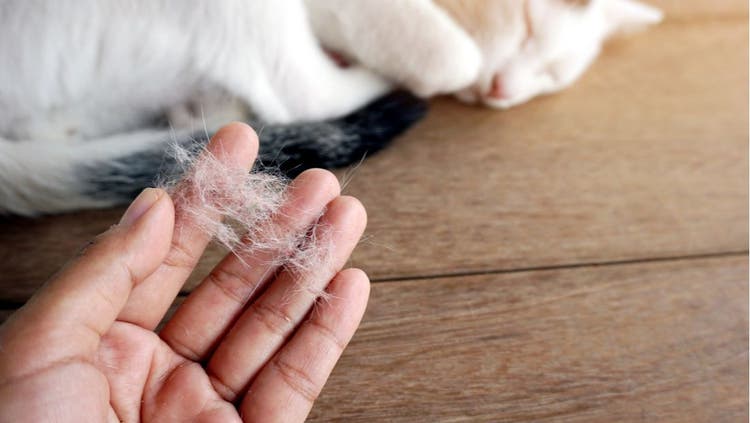
How to Control Excessive Shedding in Cats
It seems as though there is cat hair everywhere and all the time when you have cats. All cats shed and if they are indoors, they can shed all year long. Shedding is a normal part of a healthy hair lifecycle. While shedding in cats is normal…excessive shedding is not.
First, let’s review normal skin and hair patterns and reasons for excessive shedding.
Normal Cat Skin and Hair
The hair, skin, claws, and pads are made up of what is referred to as the integumentary system. Hair is located on the external part of the skin and is the barrier to the body. Disorders of the hair are part of problems with the skin.
The outermost layer of the skin is called the epidermis. Just under the epidermis is the dermis which is comprised of hair follicles, nerve endings, connective tissue, blood vessels, as well as sweat and oil glands. The dermis supports the hair follicles that generate the root of each hair.
Each hair in a cat is made up of the root, which is seated within the skin itself, and the shaft, which is the visible portion of the hair.
Function and Types of Cat Hair
The hair coat functions as the layer between the external environment and the skin. It protects a cat from the cold and the heat and sun.
Most cats have three types of hair.
- Guard hairs – coarse, long, straight hairs found in the outer coat
- Awn hairs – medium length hairs that make up the intermediate coat
- Undercoat hairs – soft, short fluffy fur that can be wavy
Typical Cat Shedding
The shedding cycle in cats is made up of three phases. They include:
- Anagen – Active growth phase
- Catagen – The transition phase
- Telogen – Rest phase
The cycle of shedding in cats is influenced by daylight, referred to as the photoperiod. The amount of sunlight a cat gets influences the shedding cycle. Shedding is common in all cats but most obvious in outdoor cats during changes in daylight such as spring when exposed to natural light. Cats have the heaviest haircoats in the winter so they can keep warm and the lightest in the summer so they can be cool. Indoor only cats have less variance in their shedding cycles since they have less direct exposure to sunlight and significant exposure to artificial light.
How to Recognize Excessive Shedding in Cats
Excessive shedding is defined as shedding more than normal. Because we don’t welcome cat hair in our homes or on our clothes, it sometimes makes it difficult to determine normal shedding from excessive shedding since they seem to shed all the time.
When do you worry about excessive shedding? When you see any of the following on your cat there should be considerations about excessive shedding:
- When you see generalized hair loss
- Dull thin hair coats
- Frequent clumps of hair around the house
- Focal areas of hair loss
- When the generalized shedding is associated with other problems such as scratching, weight loss, decreased appetite, lethargy, vomiting, or diarrhea
- Hair loss around the ears with head shaking or scratching at the ear area. Cat Ear Infection: What to Do.
- When you see fleas or evidence of fleas. Learn more Treatments for Cat Fleas.
Causes of Excessive Cat Shedding
There are different reasons for excessive cat shedding or hair loss. Some of the causes include:
- Focal hair shedding can be caused by local wounds, allergies, fleas, parasitic infections, bacterial infections, yeast infections, and ringworm. Some cats will even lick excessively at an area of pain such as a joint or over the area of their bladders. Learn more about What to Do if Your Cat Has a Urinary Tract Infection.
- Generalized excessive cat shedding and be caused by poor nutrition, illness, and stress in cats. One of the first signs owners notice of illness in their cat is excessive shedding, dandruff or flaking skin and/or matting. Matting can be caused by a lack of grooming which is common when a cat does not feel well.
How to Limit Excessive Shedding in Cats
Different cats can have different types and lengths of hair. For example, purebred cats can range from nearly hairless to longhaired. The domestic run-of-the-mill cats are commonly categorized as domestic shorthaired (DSH), domestic medium-haired (DMH) and domestic long-haired (DLH). It can seem like longhaired cats may shed more than shorthaired cats but they basically shed the same.
If you believe your cat is shedding excessively, the best thing to do is to have your cat evaluated by your veterinarian. They can help evaluate your cat for signs of infection, parasites, mites, or fungal, bacterial and yeast infections. They can also help evaluate your cat’s overall health by looking for systemic signs of illness that can cause excessive shedding.
The best way to control shedding in cats is to provide your cat with routine grooming. Regular combing and brushing help remove dead hair. You can use “grooming gloves” for cats with very close haircoats such as the Siamese or a round boar’s hair bristle brush for medium-coated cats like American shorthairs. “Greyhound Style Combs,” and “peak” combs work well on long-haired cats. The Furminator® is a grooming tool that can be used on various types of hair coats from short to long and really helps get out the dead undercoat.
There are numerous products on the market that claim to reduce daily shedding when given as a supplement or topical application. Their effectiveness is questionable at best.